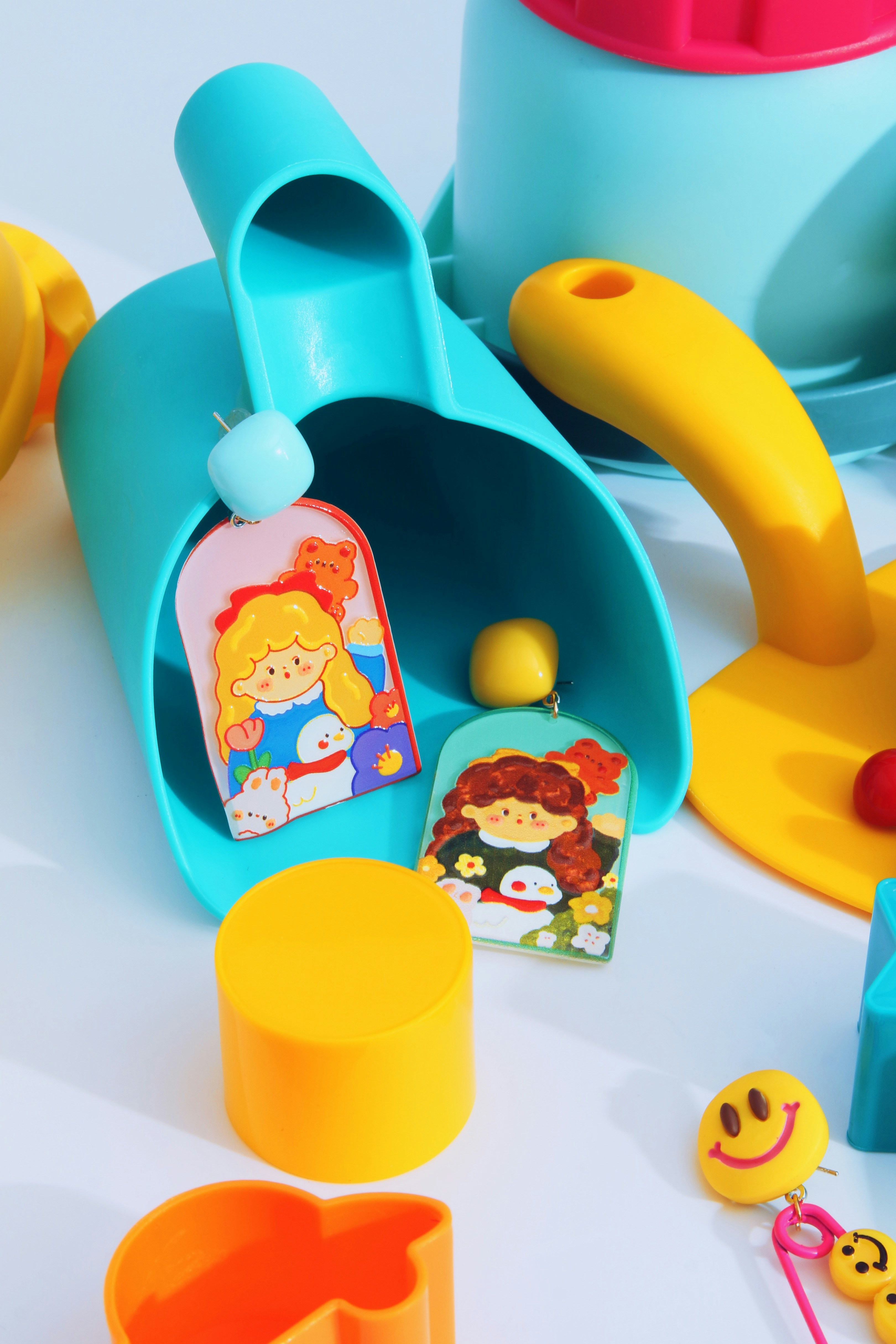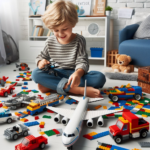
Introduction to the World of Toys
Toys have been an integral part of human culture and development for centuries, serving as essential tools for play and learning. Their historical context can be traced back to ancient civilizations, where items such as stones, sticks, and handcrafted figures were used to entertain and educate children. Over time, the evolution of toys has reflected societal changes, technological advancements, and a growing understanding of child development.
The significance of play cannot be overstated, as it is a natural and vital aspect of childhood. Play serves not only as a source of entertainment but also as a means for children to explore their environment, practice social skills, and develop cognitive abilities. Toys act as facilitators of play, stimulating imagination and creativity, while also providing opportunities for problem-solving and critical thinking. Engaging with toys allows children to experiment and learn crucial life skills in a safe and enjoyable manner.
The landscape of toys has transformed dramatically over the years, ranging from traditional wooden toys to modern electronic devices. This evolution reflects both cultural shifts and advancements in technology, resulting in a diverse array of options suitable for children of all ages. Today, toys can be categorized into various types, each serving different developmental purposes. These include educational toys that foster learning, social toys that encourage cooperative play, and sensory toys that stimulate emotional well-being. The increasing awareness of child psychology has further influenced toy design, emphasizing the importance of toys that promote not only physical dexterity but also emotional resilience.
Understanding the importance of toys is essential for parents, educators, and caregivers. By recognizing their impact on a child’s development and overall well-being, adults can make informed choices about the types of toys that best serve the varying needs of children as they grow. This foundational knowledge paves the way for a deeper exploration of the diverse categories of toys and their unique benefits, which will be discussed in subsequent sections of this blog post.
Infant Toys: Stimulating the Senses
Infants possess a remarkable ability to learn and develop through play, and the toys they interact with serve as valuable tools in this process. Toys designed specifically for infants, such as rattles, soft toys, and sensory play items, not only entertain but also stimulate the senses. Rattles, for instance, engage infants through sound and movement, encouraging them to shake, grasp, and explore. The bright colors and varied textures of these toys stimulate visual and tactile senses, essential for cognitive growth.
Soft toys, often made from plush materials, can provide comfort and security for infants. These toys promote the development of fine motor skills as babies learn to grasp, hold, and manipulate them. The soothing feel of soft toys can also create a calming environment for infants, helping them to relax and focus on their surroundings. As they cuddle and interact with their soft toys, infants begin to form emotional connections, which are crucial for their social and emotional development.
Sensory play items take this developmental process a step further by appealing to multiple senses simultaneously. Toys that crinkle, squeak, or have various textures engage an infant’s hearing and touch senses, fostering curiosity and exploration. These toys can enhance hand-eye coordination and spatial awareness as infants learn to track moving objects and understand distance. Furthermore, safe materials are paramount; selecting toys free from toxic substances ensures infants can explore their environment without risk.
In conclusion, the right toys can significantly impact an infant’s sensory development, motor skills, and cognitive abilities. Selecting toys that appeal to their senses and are made from safe materials will provide them with a well-rounded and enriching early play experience.
Toddlers and Their Developmental Playthings
Toddlers between the ages of one and three are at a pivotal stage in their development, where play serves as a crucial tool for learning and growth. The type of toys they engage with can significantly impact various aspects of their development, including cognitive skills, motor coordination, and social abilities. Building blocks, simple puzzles, and stuffed animals are exemplary choices that promote these essential developmental milestones.
Building blocks, for instance, not only stimulate creativity but also enhance problem-solving skills. As toddlers manipulate these blocks, they learn about balance, spatial awareness, and the fundamentals of construction. Such activities foster critical thinking, as children begin to experiment with different arrangements, testing their ideas in real-time. Furthermore, these toys encourage fine motor skills as toddlers grasp, stack, and balance the blocks, which is essential for their physical development.
Simple puzzles serve as another beneficial toy, aiding in language acquisition and cognitive understanding. When toddlers engage with puzzles, they learn to recognize shapes, colors, and patterns, all of which are vital for their cognitive growth. Additionally, as they verbalize the objects they are placing, they develop their vocabulary and language skills. This type of play can also be a social activity, helping children learn to share, take turns, and communicate with peers or caregivers, thereby bolstering their social skills.
Lastly, stuffed animals may seem like mere comfort items, but they play a significant role in imaginative play. Through interactions with their stuffed friends, toddlers explore emotions, practice empathy, and develop storytelling capabilities. This imaginative aspect of play is not only enjoyable but also critical for emotional growth, as it allows children to work through their feelings and experiences in a safe and constructive way.
In light of these insights, it becomes clear that selecting the right toys for toddlers is essential in supporting their multifaceted development. The toys mentioned provide an invaluable foundation for learning that can enhance physical coordination, cognitive abilities, and social interactions.
Preschoolers: Fostering Creativity and Learning
Preschoolers, typically aged three to five years, are at a crucial stage of development where toys play a significant role in fostering creativity and learning. At this age, children are highly curious, eager to explore their environment, and begin to define their interests. Therefore, selecting the right type of toys can significantly influence their cognitive, emotional, and social growth.
Arts and crafts supplies, for example, provide preschoolers with an outlet for self-expression. Engaging in creative activities such as drawing, painting, or molding clay not only allows children to express their imagination but also enhances their fine motor skills. When children grip crayons or scissors, they develop the hand-eye coordination essential for future writing and other tasks. Moreover, open-ended art projects encourage problem-solving skills, as children learn to navigate their artistic choices and outcomes.
Educational games tailored for this age group can also be highly beneficial. Games that involve counting, letter recognition, or simple puzzles stimulate cognitive development. These toys can make learning fun and interactive, providing opportunities for preschoolers to absorb knowledge without the pressure of a formal learning environment. Engaging in these activities with peers further promotes collaboration and communication, essential skills for their social interactions.
Role-playing toys, such as play kitchens, doctor kits, or construction sets, facilitate imaginative play, which is vital for emotional and social development. Through role-playing, preschoolers can explore different scenarios, understand social roles, and practice empathy by placing themselves in others’ shoes. This is pivotal for developing emotional intelligence, as children learn to navigate feelings and understand the perspectives of their peers. Overall, the right selection of toys for preschoolers serves not just as playtime activities but as integral components of their growth and learning journey.
School-Age Children: Encouraging Independence and Critical Thinking
As children reach school age, their cognitive and social skills develop significantly, leading to increased interest in toys that challenge their creativity and foster independence. At this stage, it is essential to provide toys that not only entertain but also stimulate learning. Board games, science kits, and sports equipment are exemplary choices that can contribute to a child’s developmental growth.
Board games are particularly effective in promoting critical thinking and problem-solving skills. They encourage children to strategize, plan, and make decisions while also teaching them the importance of teamwork and communication. Through games that require collaboration, children learn how to work effectively with others, enhancing their social interactions and fostering a sense of community among peers. Additionally, the competitive nature of board games can instill resilience as children learn to cope with winning and losing gracefully.
Science kits offer a hands-on approach to learning that deepens a child’s understanding of scientific concepts. These kits stimulate curiosity and exploration, allowing school-age children to conduct experiments and discover principles of physics, chemistry, and biology. Engaging with science kits can promote independent learning and enhance problem-solving skills as children navigate challenges and analyze outcomes. The satisfaction of achieving results through experimentation further boosts their confidence and critical thinking abilities.
Lastly, sports equipment introduces physical activity into playtime, which is crucial for developing gross motor skills and promoting a healthy lifestyle. Whether it’s a soccer ball, a basketball hoop, or a bicycle, these toys encourage children to be active, fostering independence as they learn to manage and engage in sports without adult supervision. Participation in sports also cultivates teamwork and communication skills and helps build emotional resilience through both competition and cooperation. Overall, toys for school-age children play an instrumental role in encouraging not just play, but valuable life skills that will benefit them well into adulthood.
Toys for Tweens: Balancing Fun and Growth
Tweens, typically defined as children aged 9 to 12 years, stand at a unique developmental crossroads where their interests begin to shift significantly. At this stage, toys and games increasingly play a key role in both enjoyment and personal growth. The array of available options ranges from tech gadgets to intricate building sets and sports gear, each serving a distinct purpose in a tween’s life.
Tech gadgets, such as programmable robots or interactive learning tablets, stimulate critical thinking and problem-solving skills. These toys encourage tweens to explore technology, fostering not just enjoyment but also an understanding of foundational coding and robotics principles. Engaging with such gadgets can ignite a passion for STEM (science, technology, engineering, and mathematics), paving the way for future academic pursuits and career interests.
Complex building sets, like those from LEGO or construction kits, provide a hands-on approach to creativity and engineering. As tweens manipulate pieces to craft unique structures, they develop spatial awareness and fine motor skills. Collaborating with peers on these projects can enhance teamwork abilities, a vital aspect as they navigate social dynamics during these formative years. Furthermore, the sense of accomplishment that comes from building something from scratch can bolster self-esteem.
Team sports gear also plays a critical role in this age group. Engaging in sports not only promotes physical health but also teaches important life skills such as leadership, cooperation, and conflict resolution. Whether it’s through joining a soccer team or participating in after-school volleyball, the social interactions inherent in sports help tweens learn how to communicate effectively and work harmoniously with others. It is through these interactions and experiences that they forge lasting friendships and connect with peers.
Ultimately, the toys and games that cater to tweens should emphasize a balance between stimulating fun and meaningful growth. This balance ensures that while they enjoy their leisure time, they are also developing skills and interests that will serve them well into adulthood.
Teenagers and the Decline of Traditional Toys
As children transition into their teenage years, the nature of play evolves significantly, marking a noteworthy decline in the reliance on traditional toys. This shift can be attributed to various factors, including the allure of technology and the increasing dominance of video games. For teenagers, play has transformed into a more complex form of engagement that encompasses both entertainment and social interaction, often facilitated by digital platforms.
In today’s digital age, video games serve as a primary source of entertainment for many adolescents. These interactive experiences often offer immersive environments that allow teenagers to explore vast worlds, solve complex puzzles, and engage in competitions with peers globally. The advantages of entertainment technology are multifaceted. It has been shown that video gaming can enhance hand-eye coordination, boost strategic thinking, and improve problem-solving skills. Furthermore, many games have social components that allow teenagers to connect with peers, fostering collaboration and teamwork.
Despite the decline of traditional toys, it is essential to recognize the benefits that modern entertainment technology can offer. While classic playthings such as dolls, action figures, and building blocks have been pushed to the sidelines, they provided fundamental developmental skills that are still crucial during the teenage years. However, the digital alternatives are gradually filling this void with new dimensions of cognitive engagement.
The decline in traditional toys does not solely reflect a negative trend; it demonstrates an adaptation to new forms of play that resonate with the interests and realities of modern adolescents. Understanding this transition is crucial for parents and educators, who must adapt their support for teenagers as they navigate the complexities of play and socialization in today’s technology-driven environment.
Benefits of Toys Across All Ages
Toys play a significant role in the holistic development of individuals across all age groups. From infants to seniors, the multifaceted benefits of toys are profoundly intertwined with mental health, emotional growth, and social interaction. Engaging with toys encourages exploration and creativity, allowing individuals to navigate their environments and develop essential skills.
For infants and toddlers, toys stimulate sensory development and fine motor skills. Simple toys, such as blocks and rattles, provide opportunities for exploration that aid cognitive growth. As children grow, toys evolve in complexity, fostering critical thinking, problem-solving abilities, and imaginative play. This period is vital for building foundational social skills, as children learn to share, cooperate, and communicate with peers. Educational toys like puzzles or construction sets are designed to enhance cognitive abilities while making learning enjoyable.
As children transition to adolescence, toys, mainly in the form of games and technology, continue to be instrumental in providing a platform for socialization. These tools help develop teamwork, strategic thinking, and decision-making skills. Furthermore, the emotional aspect of play remains significant, as it allows adolescents to express themselves and cope with various life challenges.
For adults, engaging with toys and games can serve as a stress-relief mechanism. Whether it is through board games, puzzles, or more interactive experiences, play offers an opportunity to unwind and foster relationships. It is essential to acknowledge that the importance of play does not diminish with age; rather, it adapts and manifests differently. Overall, toys are vital for personal growth, creating an understanding that play is integral to a fulfilling life, no matter the stage of development one is in.
Choosing the Right Toys for Every Stage
When it comes to selecting toys for children, it is essential for parents and caregivers to be thoughtful and informed. Choosing age-appropriate toys not only aligns with the child’s developmental milestones but also supports their interests, catering to their evolving needs. For infants, toys that stimulate sensory exploration, such as soft rattles or colorful mobiles, aid in developing visual and auditory skills. As children transition into toddlerhood, consider toys that encourage imaginative play and fine motor skills, such as building blocks and puzzles. These types of toys also promote problem-solving capabilities, which are crucial at this stage.
For preschoolers, toys that foster creativity and social interaction should be prioritized. Art supplies, pretend playsets, and cooperative games can enhance their imaginative abilities and improve communication skills. School-age children may benefit from more complex toys like science kits or board games, which can introduce concepts of teamwork, strategy, and critical thinking. At this stage, balancing educational value with fun is particularly important, as children become more aware of their preferences and interests. Engaging children in the selection process can also promote a sense of ownership and excitement about their toys.
For older children and adolescents, toys and games should shift towards more sophisticated challenges, including advanced construction sets, electronic gadgets, and books tailored to their interests. Moreover, incorporating a variety of experiences and toys encourages diverse play patterns. This variety helps children develop a broad skill set and fosters adaptability. In conclusion, being mindful of age appropriateness, developmental readiness, and individual interests will ensure that children receive toys that not only entertain but also contribute positively to their growth and learning across different stages of life.






